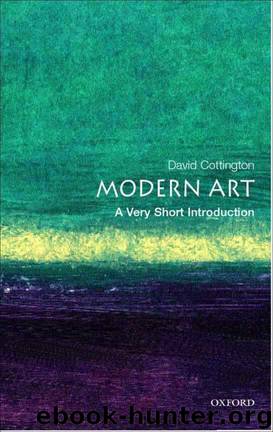Modern Art: A Very Short Introduction (Very Short Introductions) by Cottington David

Author:Cottington, David [Cottington, David]
Language: eng
Format: mobi, epub
Publisher: Oxford University Press
Published: 2005-02-23T16:00:00+00:00
Those four years were the period in which, with Georges Braque, he fashioned the deep structure and radical vocabulary of a style of painting – christened ‘cubism’ by its critics – whose potential for generating new anatomies and new meanings gave it the status of a model for modernism that I have earlier noted. ‘Braque was my wife’, Picasso famously recalled in later life of their partnership in cubism; Braque’s own preferred metaphor was that of ‘two climbers roped together on a mountain’. Between them these images summarize pithily the combination of sexism, adventure, and machismo that characterized the first-generation avant-gardes – whose progressive, modernist interrogation of prevailing artistic convention was unfortunately routinely accompanied by a regression to pre-modern sexual relations. As Carol Duncan noted 30 years ago, the work of these avant-gardes ‘defines a new artist type: the earthy but poetic male, whose life is organised around his instinctual needs’, and whose art ‘depicts and glorifies what is unique in the life of the artist – his studio, his vanguard friends, his special perceptions of nature, the streets he walked, the cafés he frequented’. In this culture, and this vanguard endeavour, women were not included as equals; with very few exceptions, the roles they could occupy were limited to those of mistress, muse, or manager of their partner’s career. Indeed, as the discourse of modern art was elaborated over most of the 20th century, the exclusion went deeper than behaviour alone. While this self-conscious bohemianism slowly gave way to more ‘bourgeois’ habits as the avant-garde formations became settled and normalized, its masculinism found expression in the aesthetic principles on which most modernist art came to be built. These principles were defined – by artists, critics, and historians – not only as positive qualities but also against alternatives, in what cultural historian Peter Wollen calls ‘a cascade of antinomies’. Thus modernism can be seen, as he suggests, to have privileged the constructive over the decorative (thus, the linear geometries of Picasso’s cubism over the sensuousness of Matisse’s colour); the machine as against the body (‘the house is a machine for living in’, modernist architect Le Corbusier once famously declared); economy over excess; West as against East – in a set of oppositions (others could be added) underpinning which was that of ‘masculine’ as against ‘feminine’. As a result, not only was art by women modernists assumed to be secondary unless (and sometimes even when) it displayed these preferred qualities, but it was at times by definition invisible. Thus, among many others, Sonia Delaunay, a pioneer in the fields of abstract painting, fashion, and graphic design from 1910 to 1970, and Lee Krasner, a painter at the forefront of mid-20th-century New York abstraction, were both until recently sidelined as imitators of Robert Delaunay and Jackson Pollock, their respective husbands. And, to take another example, the desire whose liberation surrealism sought was male desire; as such, it was hardly possible that there could be women surrealists of any importance. This is how
Download
Modern Art: A Very Short Introduction (Very Short Introductions) by Cottington David.epub
This site does not store any files on its server. We only index and link to content provided by other sites. Please contact the content providers to delete copyright contents if any and email us, we'll remove relevant links or contents immediately.
The Art of Boudoir Photography: How to Create Stunning Photographs of Women by Christa Meola(18511)
Red Sparrow by Jason Matthews(5375)
Harry Potter 02 & The Chamber Of Secrets (Illustrated) by J.K. Rowling(3614)
In a Sunburned Country by Bill Bryson(3471)
Drawing Cutting Edge Anatomy by Christopher Hart(3444)
Figure Drawing for Artists by Steve Huston(3366)
Harry Potter and the Prisoner of Azkaban (Book 3) by J. K. Rowling(3298)
The Daily Stoic by Holiday Ryan & Hanselman Stephen(3217)
Japanese Design by Patricia J. Graham(3101)
The Roots of Romanticism (Second Edition) by Berlin Isaiah Hardy Henry Gray John(2870)
Make Comics Like the Pros by Greg Pak(2840)
Stacked Decks by The Rotenberg Collection(2799)
Draw-A-Saurus by James Silvani(2638)
Harry Potter and the Deathly Hallows (7) by J.K. Rowling(2631)
Tattoo Art by Doralba Picerno(2589)
On Photography by Susan Sontag(2567)
Churchill by Paul Johnson(2497)
The Daily Stoic by Ryan Holiday & Stephen Hanselman(2445)
Drawing and Painting Birds by Tim Wootton(2425)
